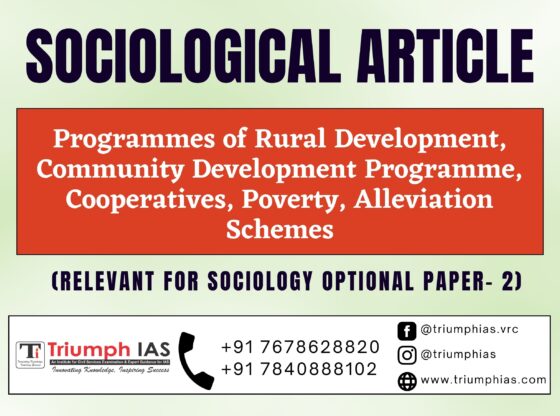Programmes of Rural Development, Community Development Programme, Cooperatives, Poverty, Alleviation Schemes
Relevant for sociology optional Paper- 2 (Unit- 13 : Social Changes in India)

Rural development is a crucial aspect of a country’s overall development. India, being a predominantly agricultural country, has a significant portion of its population living in rural areas. The government has initiated several programs and schemes to uplift the rural communities and provide them with better living conditions. This article will discuss some of the prominent programs of rural development, community development programs, cooperatives, poverty alleviation schemes in India.
Community Development Programme (CDP) was launched in India in 1952 with the aim of bringing about social and economic transformation in rural areas. The main objective of this program was to promote self-help, mutual cooperation, and participatory approach in rural development. The program emphasized the need for the active involvement of the rural community in identifying their problems and finding solutions to them. It was a multi-disciplinary program that aimed at improving agriculture, education, health, and sanitation facilities in rural areas. However, the program was not very successful as it suffered from poor planning, lack of funds, and inadequate implementation.
The Integrated Rural Development Programme (IRDP) was launched in 1978 as a comprehensive program to alleviate rural poverty. The program aimed at creating sustainable livelihood opportunities for the rural poor and to enable them to become self-reliant. The program provided financial assistance to the rural poor for various income-generating activities like agriculture, animal husbandry, small-scale industries, and handicrafts. The program was successful in providing some relief to the rural poor, but it suffered from implementation problems like corruption and bureaucratic hurdles.
National Rural Employment Guarantee Act (NREGA) was launched in 2005 to provide employment to the rural poor and to create sustainable assets in rural areas. The program guaranteed 100 days of employment to every household in rural areas. The program provided wages for unskilled manual labor like digging wells, building roads, and constructing public infrastructure. The program was successful in providing employment to the rural poor and creating sustainable assets in rural areas.
Pradhan Mantri Gram Sadak Yojana (PMGSY) was launched in 2000 to provide all-weather road connectivity to rural areas. The program aimed at connecting all the villages with a population of 500 and above with all-weather roads. The program was successful in providing road connectivity to rural areas, which improved their accessibility to markets, health facilities, and education centers.
National Rural Livelihood Mission (NRLM) was launched in 2010 to alleviate rural poverty by promoting self-employment and entrepreneurship among the rural poor. The program aimed at creating sustainable livelihood opportunities for the rural poor by providing them with financial assistance, training, and technical support. The program was successful in creating self-employment opportunities for the rural poor and promoting entrepreneurship in rural areas.
Cooperatives are voluntary organizations formed by individuals who come together to meet their common economic, social, and cultural needs and aspirations through a jointly owned and democratically controlled enterprise. Cooperatives have played a significant role in rural development in India by providing credit, marketing, and storage facilities to farmers. The National Cooperative Development Corporation (NCDC) was set up in 1963 to promote and develop cooperative societies in rural areas. The NCDC provides financial assistance and technical support to cooperative societies in the country.
Poverty Alleviation Schemes are programs launched by the government to provide relief to the poor and vulnerable sections of society. Some of the prominent poverty alleviation schemes in India are:
- Pradhan Mantri Garib Kalyan Yojana (PMGKY) was launched in 2016 to provide relief to the poor and vulnerable sections of society during the demonetization drive. The program provided financial assistanc
- Pradhan Mantri Ujjwala Yojana (PMUY) was launched in 2016 to provide clean cooking fuel to women in rural areas. The program aimed at reducing the health hazards caused by traditional cooking fuels like wood and coal. The program provided LPG connections to women below the poverty line and also provided financial assistance to meet the initial cost of the connection. The program was successful in providing clean cooking fuel to women in rural areas and reducing the health hazards caused by traditional cooking fuels.
In conclusion, the government of India has initiated several programs and schemes to uplift the rural communities and provide them with better living conditions. The programs discussed in this article, namely the Community Development Programme, Integrated Rural Development Programme, National Rural Employment Guarantee Act, Pradhan Mantri Gram Sadak Yojana, National Rural Livelihood Mission, Cooperatives, and Poverty Alleviation Schemes, have played a significant role in rural development in India. These programs have provided employment opportunities, financial assistance, and basic amenities to the rural poor and have contributed to their socio-economic development.
For more such free UPSC notes, Articles, News & Views Join our Telegram Channel. https://t.me/triumphias
Click the link below to see the details about the UPSC – Civils courses offered by Triumph IAS. https://triumphias.com/pages-all-courses.php


